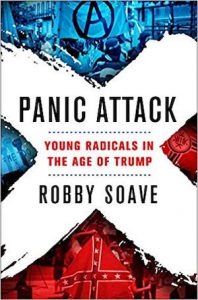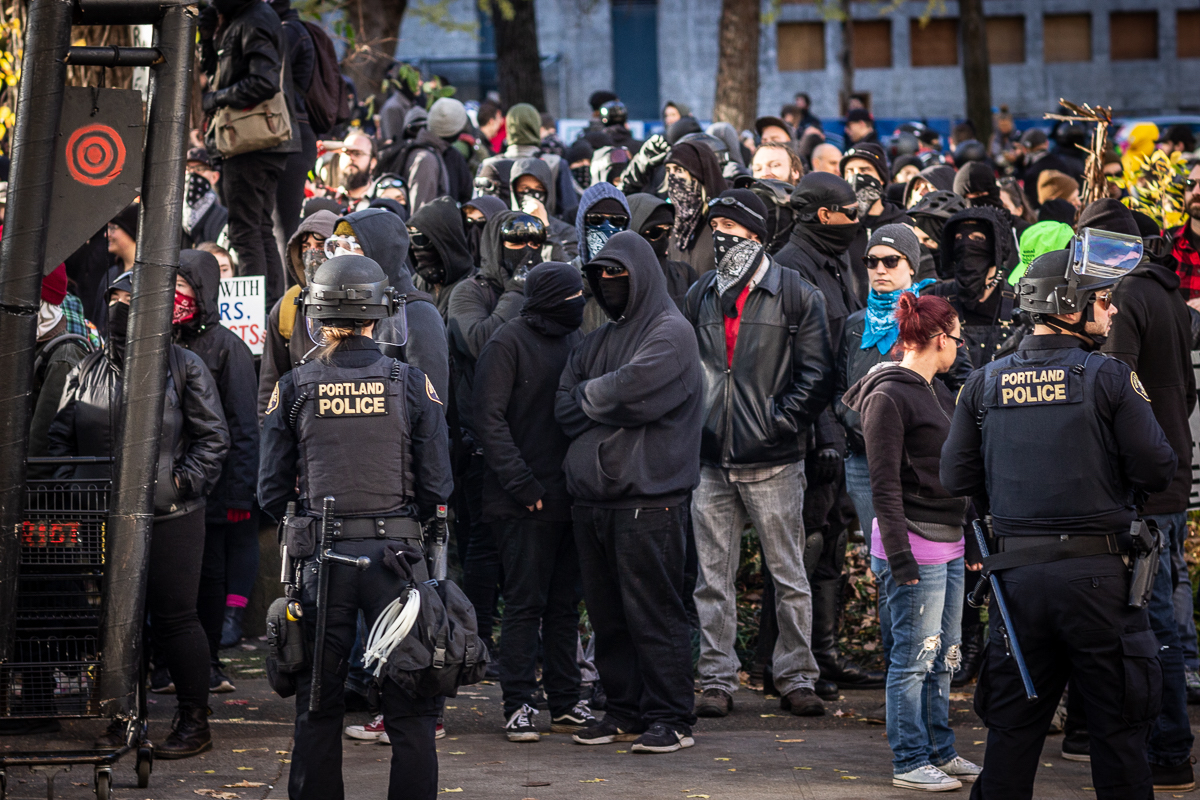Activism
How Antifa's Apologists Fell in Love With Street Violence
Antifa movements have sprung up in a variety of countries, often opposing Nazis and Nazi sympathizers while also promoting general far-left politics of the Marxist and communist variety.


A day before the 2017 Women’s March, spectators and activists of all stripes descended on Washington, D.C. for the inauguration of President Trump. Supporters of the new president wore “Make America Great Again” baseball caps and toted “Trump-Pence 2016” signs. Detractors were more colorful.
“Trump is the symptom, capitalism is the disease, socialism is the cure,” read one sign, wielded by a woman with a T-shirt depicting a clenched fist.
Others were at least funny: I spotted a man holding a sign featuring a cartoon Batman slapping Trump in the face with the caption “Stop tweeting!”—a parody of a drawing from the Batman comics, in which the caped crusader slaps Robin.
The demonstrations were mostly peaceful. Mostly.
Masked protesters known simultaneously as the “black bloc” (because they wear black clothes and hoods to mask their identities) and “antifa” (as in anti-fascist) smashed the windows of a local Starbucks and a Bank of America. They also set a limousine on fire. How these acts of property damage were intended to undermine Trump remains a mystery, given that the CEO of Starbucks and many Bank of America employees were financial supporters of the Hillary Clinton campaign. The limo driver, we learned, was a Muslim immigrant.
A rioter knocked a friend of mine, the journalist Philip Wegmann, to the ground, causing him to briefly lose consciousness—even though, Wegmann told me, he was wearing credentials that clearly identified him as a member of the press. Wegmann is a writer for conservative news outlets such as Washington Examiner and The Daily Signal, however. And one of the main principles of the new activist left is that unfriendly media organizations should not have the right to cover their activities, even on public property.
But it isn’t just conservative media outlets that bear the “unfriendly” designation; many activists are equally dismissive of mainstream news sources. One activist told me that she hates CNN just as much as Trump supporters do. Only explicitly leftist media organizations are permitted to cover the antics of the #Resistance.
Of course, the most famous victim of Inauguration Day violence was alt-right leader Richard Spencer, a white nationalist with some positive feelings about Trump. An Australian news channel was interviewing Spencer when a masked protester walked up to him and punched him in the face while the cameras were rolling.
One can—and should—strenuously object to Spencer’s racist opinions while still acknowledging his right to hold them. As a strictly legal matter, his speech is quite obviously protected by the First Amendment. The U.S. Supreme Court has carved out a few exceptions, but none of them would apply here. In the 2011 decision Snyder v. Phelps, for instance, the Court held that the virulently anti-gay Westboro Baptist Church could picket military servicemembers’ funerals, waving signs that read “God hates you” and “Fag troops.” The fact that the church’s message was objectively offensive and emotionally damaging to the families of deceased soldiers was not enough to strip it of constitutional protections. If such speech is protected by the First Amendment, you can bet Spencer’s is, too.
But this did not stop members of the left from defending—even praising—the antifa activists who struck Spencer. Natasha Lennard, an activist and journalist who participated in black bloc activities in D.C. that day, described the attack as “pure kinetic beauty” in The Nation. The window-smashing, trash-can fires, limousine-burning, and Spencer-punching “should be celebrated as an opening salvo of resistance in the era of Trump,” she wrote. Mob violence is only a problem “if you think there are no righteous mobs, or that windows feel pain, or that counter-violence (like punching Richard Spencer) is never valid.”
The most extreme members of the anti-Trump resistance have taken up the banner of antifa, a continuation—in their minds—of a movement that arose in Germany in the 1930s to counter the rise of Nazism. Antifa movements have sprung up in a variety of countries, often opposing Nazis and Nazi sympathizers while also promoting general far-left politics of the Marxist and communist variety.
Modern antifa is decentralized and relatively leaderless; many of its members are anonymous and unknown. Though they are known for wearing black masks, bandanas, and black clothing and for committing acts of destruction, antifa itself is an ideological position and does not prescribe any specific tactics. One can be opposed to fascism without endorsing black bloc tactics, property destruction, censorship or violence.
In practice, however, antifa groups tend toward illiberal means to achieve their ends—both historically and at present. In Antifa: The Anti-Fascist Handbook, Mark Bray writes that antifa explicitly rejects “the classical liberal phrase incorrectly ascribed to Voltaire that ‘I disapprove of what you say, but I will defend to the death your right to say it.’” According to Bray, “Anti-fascism is an illiberal politics of social revolutionism applied to fighting the Far Right, not only literal fascists.”
In the antifa view, their enemies started it—by making statements that serve to further marginalize people who languish under some form of oppression. Caring about intersectionality means that an attack on one disadvantaged group is an attack on all. And if it is wise to stop people on the right from speaking against any member of the coalition, then it must occasionally be necessary to silence them when they try to speak. If they will not be silenced willingly, then violence is the only alternative.
Writer for @thecolumbian joking about, mocking, and defaming @MrAndyNgo following his admission to the ER after being attacked by Antifa for reporting on the riot. pic.twitter.com/oMQI2Kax8A
— No, It’s Not Anna (@YesThatAnna) June 30, 2019
“The inherent contradiction of antifa,” wrote Carlos Lozada in his fair-minded but ultimately critical review of Antifa: The Anti-Fascist Handbook, “is that, if America is indeed so irredeemable and hypocritical that violence is the answer, then what exactly are you fighting to preserve?”
Those who defend the validity of mob violence claim that it is justifiable to the extent that it unnerves the powers that be. But do the powerful really feel threatened by a smashed Starbucks window or Richard Spencer taking a punch? The evidence strongly suggests the opposite: When leftists resort to explicit violence, they make regular people more sympathetic to governmental authority and a conservative worldview.
Princeton University’s Omar Wasow studied protest movements in the 1960s and found that violent upheaval tended to make white voters more conservative, whereas nonviolent protests were associated with increased liberalism among white voters. “These patterns suggest violent protest activity is correlated with a taste for ‘social control’ among the predominantly white mass public,” wrote Wasow in his study.
This is something that President Richard Nixon understood quite well. In 1969, he received a memo from an aide warning him to expect increased violence on college campuses in the spring. The president grabbed a pen and scrawled a single word across the document: “Good!” He knew something many activists failed to grasp: Law-and-order policies become more palatable to the silent majority when leftists are punching people in the streets.
In contrast, “nonviolent movements succeed because they invite mass participation,” says Maria Stephan, a director at the United States Institute of Peace. Violent resistance, on the other hand, is incredibly divisive. Stephan and Erica Chenoweth produced a book, Why Civil Resistance Works, which found nonviolent resistance movements were twice as likely as violent movements to achieve their aims in the 20th and early 21st centuries. “A campaign’s commitment to nonviolent methods enhances its domestic and international legitimacy and encourages more broad-based participation in the resistance, which translates into increased pressure being brought to bear on the target,” they wrote. According to Stephan and Chenoweth, governments have little trouble justifying brutal crackdowns on violent protesters, but nonviolent protesters engender greater sympathy from the public, reducing the likelihood of repression.

Based on these findings, it’s hardly surprising that Spencer himself isn’t wholly opposed to violence. “The fact that they are excusing violence against [me] inherently means that they believe that there’s a state of exception, where we can use violence,” Spencer told the Atlantic. “I think they’re actually kind of right.” When asked by a fellow traveler, Gregory Conte, whether members of the alt-right should support free speech as a general principle for the long term, Spencer responded, “No, of course not.”
To drive the point home, I asked Spencer about his attitude toward free speech (and much else; read Chapter Eight of my new book, Panic Attack: Young Radicals in the Age of Trump, for the rest of the interview). He told me he was certainly not for absolute free speech, and he thought the state should have “at least some involvement” in promoting a better society by suppressing dangerous ideas.
In any case, the idea that certain people do not deserve free speech protections is now as popular among the far left as it always was among the far right. But it didn’t use to be this way: Leftists were once firm defenders of free speech for all, even for Nazis. Amazingly, in fact, when the Nazis came to campus in the 1960s, they did so at the left’s invitation.
Adapted, with permission, from Panic Attack: Young Radicals in the Age of Trump, by Robert Soave. Copyright © by Robert Soave, Jr. All rights reserved. Published by St. Martin’s Press, 175 Fifth Avenue, New York, NY, 10010.






